ABS is an indispensable technology on cars and motorcycles. The system hasn’t yet caught on in the eMTB scene, however, even though proper braking is an essential and safety critical part of mountain biking. With the ABS G2, Blubrake introduced an intelligent braking system that promises to increase rider safety and should be compatible with any ebike. We put it to the test to find out if it can deliver on this promise.
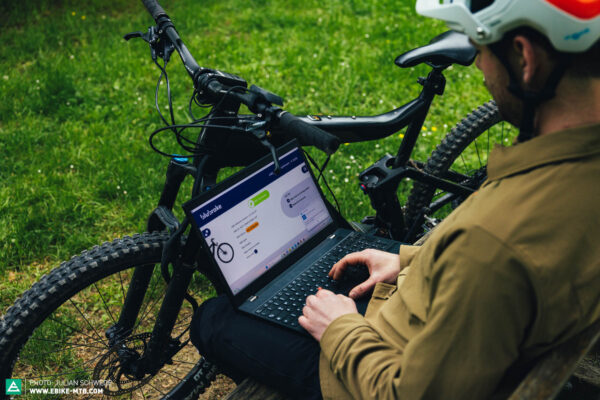

All it takes is a second where you’re not on the ball, and before you know it, you’re diving head-first into the dirt. Ouch! It’s not just inexperienced ebike riders that slam on the brakes in a knee-jerk reaction when an unexpected obstacle suddenly appears. Sometimes you can’t help but pull the brakes as hard as you can. There is no time to gauge how much traction you’ve got on the front wheel. The result: Either the front wheel locks and slides out uncontrollably or – as is more often the case – you try to brake and steer simultaneously, with the front wheel washing out from underneath you. Crashing is almost unavoidable. Another undesirable outcome of sudden braking is the dreaded OTB scenario when you fly over the bars. You squeeze the brakes, the front wheel digs in and comes to a complete stop. As your centre of gravity keeps moving forward, your fork compresses, the rear wheel lifts and the whole bike turns into an ejection seat. Alternatively, the bike comes to a stop, but the rider keeps travelling. An ebike anti-lock braking system should help prevent all the above from happening, and bring the bike to a halt in a controlled manner. The Bosch eBike ABS system has already proven that ABS is technically feasible on eMTBs, not just cars and motorcycles. However, the system was exclusive to ebikes with a Bosch motor, and a very limited number of MAGURA brake levers were available at the time of testing. Blubrake are out to remedy this with the ABS G2: an ABS that, while only available to original equipment manufacturers and not to retailers, claims to be compatible with all motors and all hydraulic disc brakes. It should also allow for discreet ebike integration. What sets the Blubrake ABS G2 apart?

With the ABS switched off, getting ejected over the bars is easier than you’d think.
The design of the Blubrake ABS G2 in detail
The whole system consists of just three components, which are relatively easy to explain. You’ve got the tone wheel on the front brake rotor. The tone wheel forms part of the tachometer, telling the system the speed at which the front wheel is rotating, allowing it to determine whether the brakes are locked. Then there is the ABS status light, which lets you know whether the system is activated or not. The status light is either placed in the frame or on the frame, or, if the motor allows, the information can also be provided on the ebike display, as in the case of BAFANG and Shimano. Finally, there’s the ABS Unit, Blubrake’s magic black box, the contents of which are a trade secret, like the ingredients of Coca-Cola. The black box weighs 380 g and measures 178 x 41 x 58 mm. The ABS unit sits in line with the front brake hose, and it’s connected to the electrical cable from the tachometer. There’s another wire that leads from the ebike battery to Blubrake’s black box, powering the system. Therefore, if the ebike battery is empty and the ebike is switched off, you’re out of luck, and you’ve got no ABS support. What’s appealing about this system is that the ABS unit can be completely integrated into the frame, that is if there is any room left. If not, the unit can also be attached to the fork. There is no aftermarket kit, so it’s up to the individual bike brands to decide if, how, and where they want to place the system. Interestingly, there’s no tachometer on the rear wheel. The Bosch eBike ABS needs it, but the Blubrake ABS G2 doesn’t, which is due to the unique way that the system works.


The theory behind the Blubrake ABS G2 system
Even though Blubrake are very secretive about the system’s details, their engineers have revealed just enough for us to understand the theory behind it. The black ABS box is equipped with multi-axial accelerometers and position sensors. Instead of matching the speed of the front and rear wheels, the ABS unit collects data from the tachometer, the hydraulic pressure on the front brake, and the sensors within the ABS unit. From this, it works out the differences between the front wheel speed, the bike frame speed – as Blubrake refer to it – and the frame movements, allowing it to tell if the front wheel is locked and the rear wheel is rising. The ABS unit reacts within fractions of a second and regulates the hydraulic pressure on the front brake, thereby preventing it from locking out. This is done by an actuator in the ABS unit, which can actively shift the brake fluid back and forth between the master and slave cylinders of the brake. The maximum braking force and pressure in the brake hose is still determined by you, with your index finger on the brake lever, but the active components in the Blubrake ABS G2 system are able to regulate the pressure, theoretically allowing it to achieve maximum deceleration without locking up the front wheel as long as you and the bike are still moving forward. However, there is one limitation: the ABS system doesn’t intervene at speeds under 5 km/h – but you’re unlikely to go over the bars at that speed anyway ;). In addition, the ABS system only affects the front wheel. If you grab the rear brake too enthusiastically, you’ll still have to reckon with a skidding rear wheel.
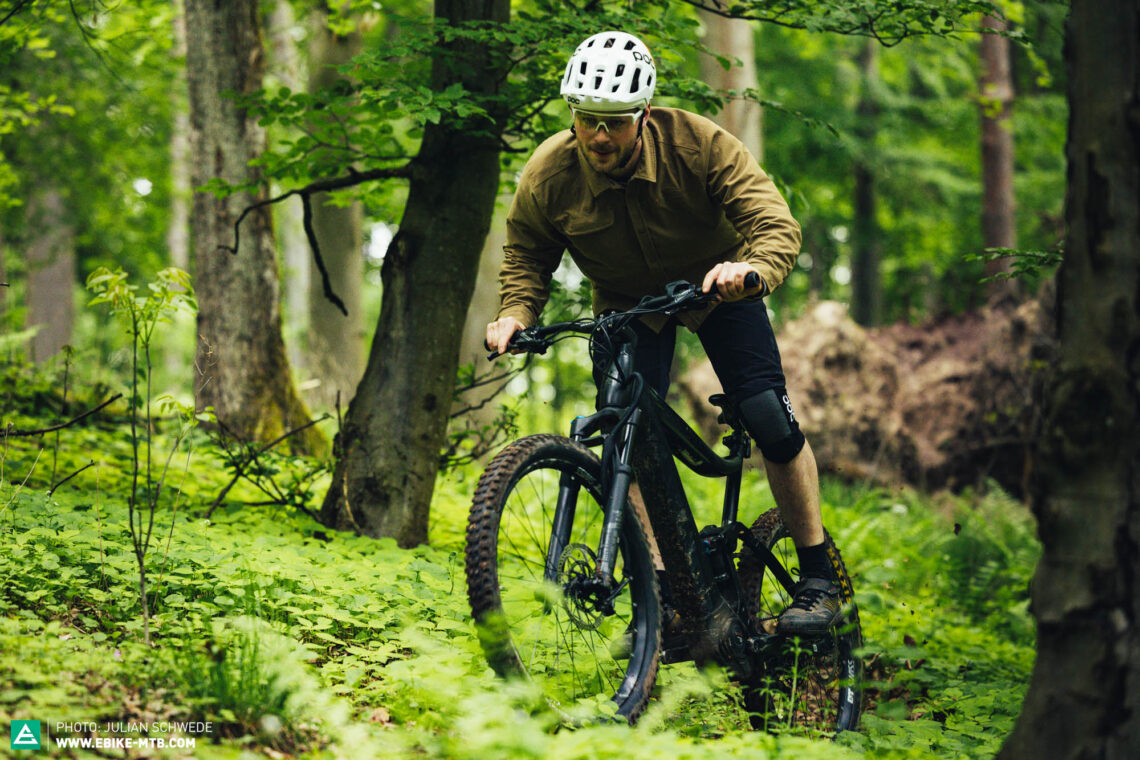
Integration, compatibility, and service intervals of the Blubrake ABS G2 system
Because the Blubrake ABS G2 system can be integrated into the frame, it is up to the manufacturer to accommodate the additional cables of the sensor, the indicator light, and the brake hoses leading to and from the ABS unit as neatly as possible. Since there are no sensors on the rear wheel, this system has fewer cables to contend with than the comparable Bosch system. That said, our BULLS test bike doesn’t deliver on this front. In this case, the ABS system has resulted in a large mess of cables around the cockpit. For bikes that don’t have any room inside the frame tubes, the system can also be attached to the fork, though this detracts from the bike’s looks even more. The motion sensors in the ABS unit are said to be capable of detecting whether the rear wheel is staying planted even if the black box is attached to the fork. The system doesn’t require an additional sensor on the frame but should be able to distinguish the bike’s from the fork’s movements resulting from braking and compression.

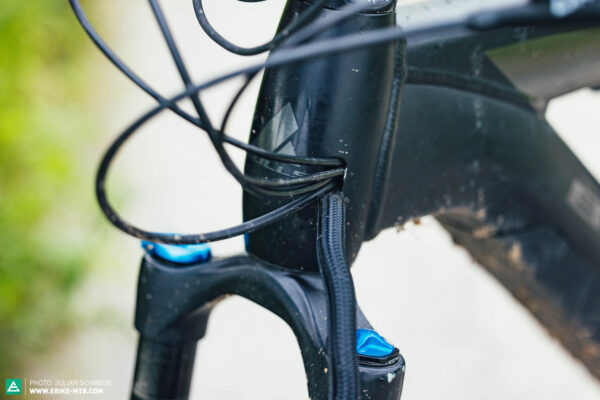
in theory, it’s possible to integrate the Blubrake ABS G2 system in a clean and unobtrusive way, but our test bike is no poster child of cable routing.
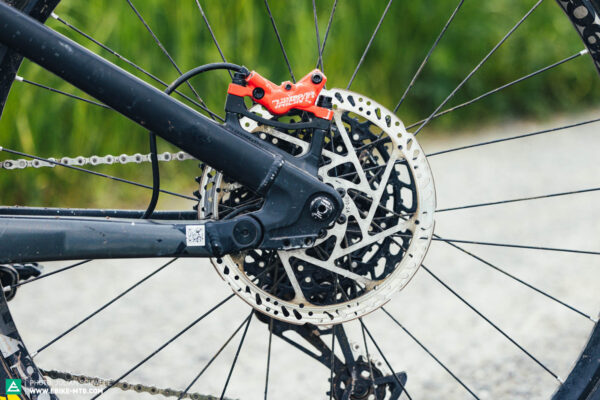
The Blubrake ABS system doesn’t regulate or monitor the rear brake. The system only manages the front brake, the red brake calliper on the rear is purely there to add some spice.
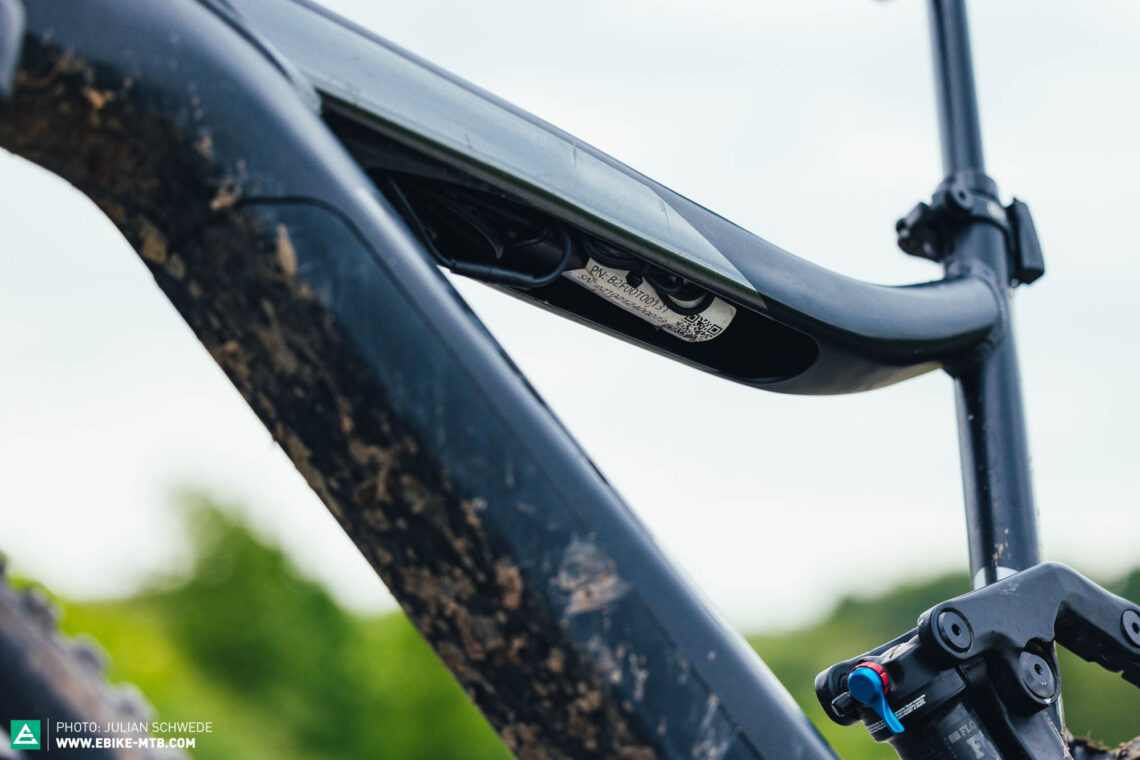
According to Blubrake, there are no restrictions as far as compatibility is concerned. The system works with both mineral oil and dot fluid brakes. Blubrake equip the system with the appropriate seals, depending on the type of brake fluid used. There are no required specifications for the brake, rotor size, or brake lever. Blubrake don’t differentiate between the different motor systems either. If the ebike has a battery, Blubrake will find a way to tap into it. You can see this on our test bike: The BULLS Copperhead EVO is equipped with a Bosch Performance Line CX motor, which is part of the closed Bosch eBike System 2 ecosystem, and usually doesn’t play well with third-party components, with the exception of lights. However, if the motor supplier is a bit more open and makes the appropriate communication protocol available, you can have the status indicator light come up on the ebike display. But that isn’t always the case. There is also a Shimano+Blubrake version of the system, though it’s based on the same principles and mechanics. The main difference is that the Shimano+Blubrake version is distributed by Shimano and used on ebikes featuring Shimano motors and brakes. So far, a handful of brands have come onboard and decided to equip their bikes with the Blubrake system. The most prominent among them are BULLS, Stromer, Thömus, and Bianchi.

As far as service intervals are concerned, the ABS system is maintenance-free and doesn’t need to be bled individually, so you can just bleed your brakes as before. Blubrake recommend having the system checked out by your local dealer on an annual basis, but it’s not required. However, if you’re going to replace the brakes entirely, you’ll do best to contact the dealer to ensure that you can continue using the system. The system is targeted at all types of ebikes: from cargo bikes to commuters, and aggressive eMTBs. Blubrake don’t exclude anyone. To ensure that the brakes work optimally, the developers at Blubrake have created different profiles for different braking characteristics.
The Blubrake ABS G2 on the trail
If the motor system doesn’t have a menu item for selecting these ABS profiles, then it’s usually up to the manufacturer to decide which profile gets used. To change the profile at a later stage, the end customer can only hope that their local dealer has got the appropriate hardware to do so. Of course, we were given a service kit from Blubrake, allowing us to test the different profiles. The profiles range from Safety to Standard, Performance, Extreme, and Off. The engagement of the ABS decreases in this order. Accordingly, the Safety profile intervenes the most, resulting in the longest braking distance, and is intended for rather inexperienced riders. With the Extreme profile, on the other hand, the ABS intervention is minimised, so this setting is only recommended for very experienced riders. There’s also a special E-Cargo profile, though we omitted that for the purposes of this test. Our BULLS Copperhead EVO test bike had the TEKTRO Orion 4P disc brakes fitted. Since the Blubrake ABS system claims to be compatible with almost all hydraulic disc brakes, the performance may vary when paired with different brakes.
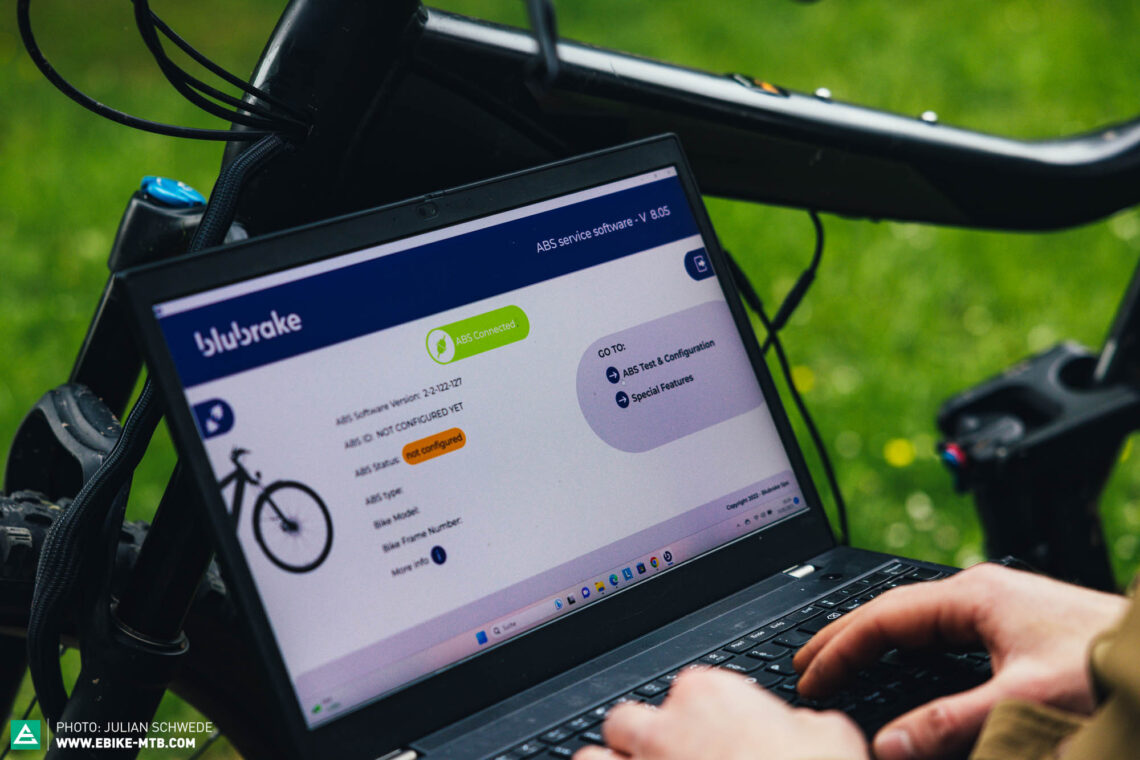
We had to use a laptop and Blubrake tuning kit to change the ABS profiles on our test bike. However, you should be able to change the profiles via the ebike display on other motor systems.
If you hit the trail with the ABS light green and the Safety profile activated, the intervention of the system doesn’t feel intuitive and is somewhat difficult to predict. Depending on the scenario, the condition of the surface, and thus the amount of grip available, it either intervenes before or after the front wheel locks. But even if the front wheel locks for a fraction of a second, it never slides out, because the ABS reacts immediately and reduces the braking force so quickly that the wheel unlocks instantly, and always remains controllable. It all happens very rapidly, but it feels somewhat jarring. The engaging and releasing of the brakes feels smoother with the Bosch eBike ABS. With the Blubrake, you can’t feel the activity of the system via the brake lever, in other words, the brake lever doesn’t pulsate, and you don’t feel the pressure fade, for example. Unlike the ABS system in a car, where you clearly feel the brake pedal juddering, the Blubrake ABS doesn’t work with a valve control or the like, resulting in an uneven oil flow and pressure. The operation of the lever feels as natural as with a standard hydraulic brake, maintaining the pressure and bite point. That also means that you don’t end up pulling the lever until it touches the handlebar. However, what decreases significantly in Safety mode is the braking performance. This also extends the stopping distance enormously, so you risk overshooting a corner, even if the front wheel doesn’t slide out, because the front wheel just keeps spinning instead of slowing you down. As such, the Safety profile isn’t suitable for use on gravel roads either. The rear wheel never leaves the ground in this mode, even if you try to provoke it by shifting your weight all the way to the front of the bike.
If you shift up to the Standard profile and repeat the test, the front wheel pushes the limits further and is more likely to lock out before the system intervenes, reducing the hydraulic pressure, and thereby reducing the braking performance. The front wheel still frees up quickly and allows you to regain control after giving you a brief fright. This ABS profile provides a significantly shorter stopping distances. Tourers and city commuters should benefit hugely from this, as it gives them better control over the front wheel on roads with limited grip, such as gravel. However, the stopping distance is still too long for aggressive trail riding. As in Safety mode, we hardly managed to get the rear wheel to lift. The Standard profile is well suited to ebike novices who spend a lot of time on gravel and poorly maintained roads. However, an experienced index finger and focused rider will still be capable of bringing the bike to a halt quicker. Let’s move on to the Performance mode.
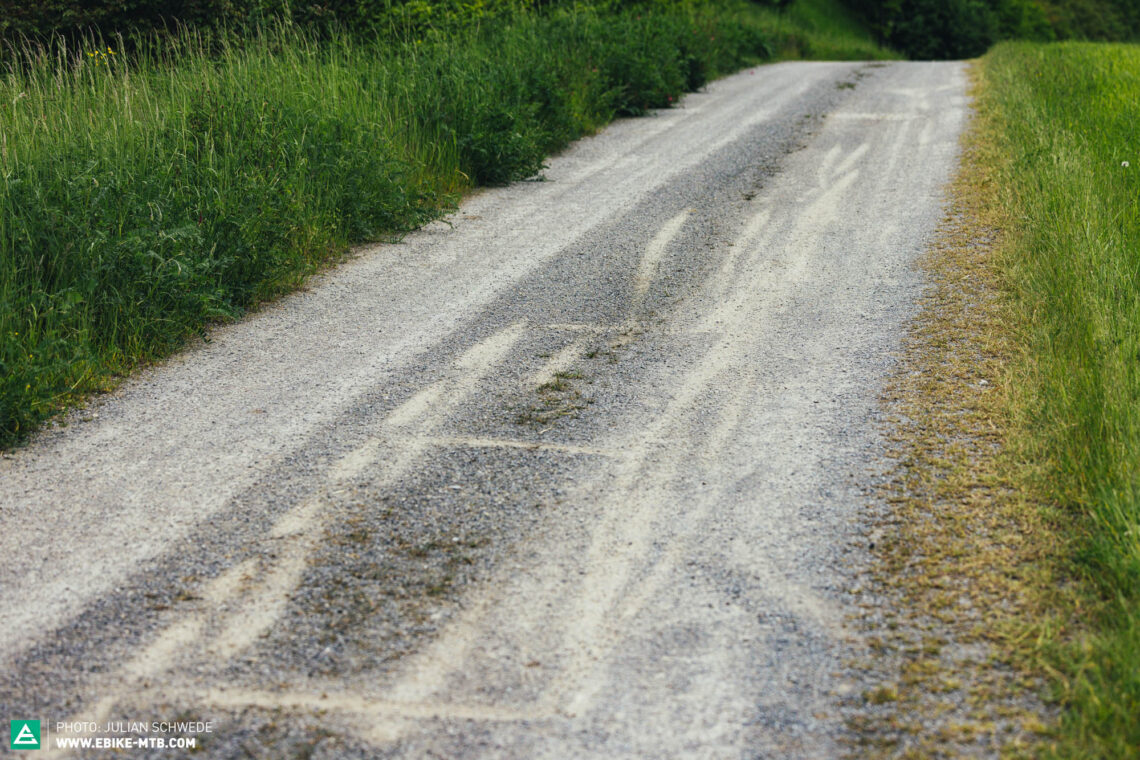
The Performance mode is the most balanced mode in our opinion and best suited for aggressive riding. On grippy terrain, the system still intervenes a little too early for our liking. Very skilled riders with an excellent feel for the bike could bring it to a halt on even shorter distances in these situations. On loose ground, the system only intervenes after you would typically have already let off the brakes yourself. We had to provoke the front wheel to lock and slide out to get the system to intervene and let you regain control, providing a lot of braking performance and short stopping distances.
As the name suggests, Extreme mode only intervenes in extreme situations, like when you get distracted or push the limits, and almost never interferes during normal trail riding situations. We had to simulate a daring full-on braking to an extent that we wouldn’t do voluntarily in any other situation to provoke the system to intervene. According to Blubrake, the mode is suitable for riders who want to nose pivot through tight switchbacks, for example. Therefore, the Extreme mode also deactivates the algorithm that stops the rear wheel from lifting. Nevertheless, the system prevented us from going over the bars by intervening in extreme situations. We believe some OTBs could have occurred if the braking force hadn’t been regulated by the Blubrake ABS G2 system. The Performance and Extreme profiles aren’t at all suitable for touring or commuting.
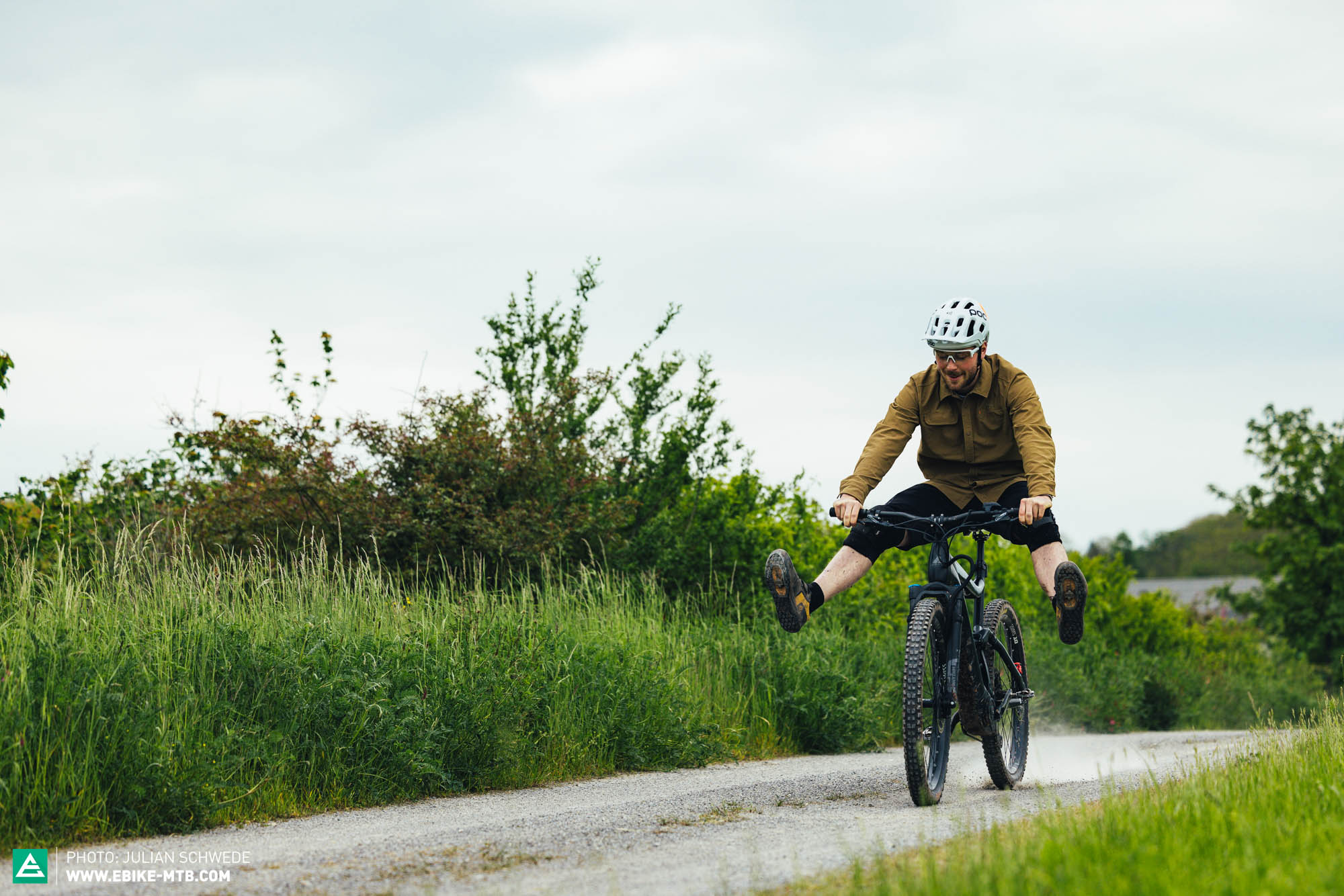
You survived an emergency braking procedure, and then what?
So, you got away with a sudden and uncontrolled braking manoeuvre with nothing but a fright? In that case, the ABS system churns out data about how close the call was, but only if the motor system plays along and takes advantage of the data supplied by the Blubrake ABS. Unfortunately, the BULLS Copperhead Evo test bike came equipped with a basic Purion display, which provides about as much information as a sundial. However, Blubrake informed us that the system captures the initial travelling speed during the braking process, the stopping distance, the braking duration, and the total number of ABS activations. It’s nice to know, but it doesn’t provide any real benefit, and it could even animate silly competitions amongst trail buddies.
Who is the Blubrake ABS G2 system for?
Blubrake’s ABS system has the potential to make ebikes safer and prevent many inexperienced riders from crashing on loose gravel roads and in slippery conditions. We liked the consistent feel of brakes during aggressive eMTB use. However, the software still needs some fine-tuning since it doesn’t hit the sweet spot of stopping distance, braking performance, and predictability in any of the profiles. Experienced riders who stay focused on the trail will stop quicker on their own. That said, skilled trail riders will benefit from the system after long days on the trails: When you’re fatigued, it’s difficult to concentrate, and you’re talking with your buddies as you’re just killing those last miles to get home, and a car suddenly backs out of parking spot in front of you. Despite good compatibility, there aren’t yet many ebikes on the market featuring the Blubrake system, which is why when looking for a bike you’ll probably focus on other features, and you’re likely to opt for a bike without the Blubrake system.
Conclusion on the Blubrake ABS G2
The Blubrake ABS G2 for ebikes is a smart anti-lock braking system that makes braking safer. The somewhat sudden intervention can be a bit jarring at first and takes some getting used to. Nonetheless, inexperienced or inattentive riders will benefit from the system, especially on long tours. Advanced trail goers are usually capable of stopping quicker on their own, though the system can still forgive the occasional rider and braking errors, keeping the eMTB on track in worst case scenarios.
Tops
- allows for discreet integration
- compatible with all brakes and motor systems
- very natural brake lever feel
Flops
- digital on/off intervention
- fine-tuning the modes offers room for improvement
For more information, visit blubrake.com
Did you enjoy this article? If so, we would be stoked if you decide to support us with a monthly contribution. By becoming a supporter of E-MOUNTAINBIKE, you will help secure a sustainable future for high-quality cycling journalism. Click here to learn more.
Words: Rudolf Fischer Photos: Julian Schwede









